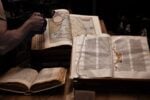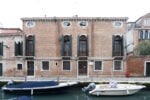Venice in Venice Glow & Reflection
Il progetto Venice in Venice Glow and Reflection – Venice California Art from 1960 to the Present è un evento collaterale della 54. Biennale di Venezia. “Riguarda gli artisti di Venice, California, che hanno creato cose basandosi su una visione assolutamente unica—l’arte. Non si basano sulla vostra auto, la vostra casa, il vostro cielo, la vostra donna, le vostre lacrime, la vostra angoscia, il vostro tormento, o qualsiasi altro riferimento alla condizione umana” (Billy Al Bengston).
Comunicato stampa
SPECIAL EXHIBITION AT THE 54TH VENICE BIENNALE TESTIFIES TO THE ART WORLD’S GROWING ANTICIPATION OF PACIFIC STANDARD TIME: ART IN L.A. 1945-1980 Venice in Venice, Organized by Foundation 20 21, Spotlights One Facet of the Art Scene Explored in Pacific Standard Time Pacific Standard Time to Participate in June 2 Round Table with Artists Peter Alexander, Billy Al Bengston, Laddie John Dill and Ron Cooper
Los Angeles, CA, May 24, 2011 – As the October 2011 opening approaches for Pacific Standard
2
Time: Art in L.A. 1945 – 1980, the excitement and anticipation has spread to the 54th Venice Biennale. As an official collateral event of the 54th International Art Exhibition, the not-for-profit organization Foundation 20 21 will present Venice in Venice-Glow and Reflection: Venice California Art from 1960 to the Present, in celebration of Pacific Standard Time. The exhibition will showcase some of the trailblazing artists whose works will be seen in Pacific Standard Time’s comprehensive circuit of more than sixty exhibitions throughout Southern California from October 2011 to April 2012. Curated for Foundation 20 21 by Tim Nye and Jacqueline Miro, Venice in Venice will be on display at the Palazzo Contarini Dagli Scrigni from June 1 through July 31, 2011, bringing to the Venice Biennale the works of more than twenty artists who have been associated with Venice, California, from the 1960s until now. Public events outside the palazzo will add to the excitement, drawing the art world’s attention in advance to the vast story of artistic innovation and social change to be told in Pacific Standard Time. “Foundation 20 21’s exhibition and programs bring together key Southern California artists from the surf town of Venice, California, to the center stage of the art world, the Venice Biennale,” stated Andrew Perchuk, Deputy Director of the Getty Research Institute and co-director of Pacific Standard Time. “This presents a wonderful opportunity to sample the new forms of art that artists in Los Angeles have been inventing for decades and to look ahead toward the grand-scale picture we will present in Pacific Standard Time.” Venice in Venice will present works by artists including Peter Alexander, Charles Arnoldi, John Baldessari, Billy Al Bengston, Larry Bell, Tony Berlant, Wallace Berman, Vija Celmins, Ron Cooper, Mary Corse, Laddie John Dill, Robert Graham, George Herms, Robert Irwin, Craig Kauffman, John McCracken, Kenneth Price, Ed Ruscha, and James Turrell. Related events will be the launching of psychedelic gondolas designed by Billy Al Bengston, the installation of skateboarding ramps in Campo San Polo and a gala outdoor concert of the music of Nino Rota and John Williams, accompanying a screening of clips from the films of Federico Fellini and Robert Altman. Rani Singh, Senior Research Associate at the Getty Research Institute and co-curator alongside Andrew Perchuk of the Getty Museum’s exhibition Pacific Standard Time: Crosscurrents in L.A. Paintings and Sculpture 1950-1970, will lead a roundtable discussion on June 2 at the Palazzo Contarini Dagli Scrigni organized by Foundation 20 21 as part of Venice in Venice. The conversation will feature California artists Peter Alexander, Billy Al Bengston, Laddie John Dill and Ron Cooper who are featured in Venice in Venice and whose work was central to the post-war Los Angeles art scene. Pacific Standard Time: Art in L.A. 1945 – 1980 is a collaboration of more than sixty cultural institutions across Southern California, coming together for six months beginning in October 2011 to tell the story of the birth of the Los Angeles art scene and how it became a major new force in the art world. Each institution will make its own contribution to this grand-scale story of artistic innovation and social change, told through a multitude of simultaneous exhibitions and programs. Exploring and celebrating the significance of the crucial post-World War II years through the tumultuous period of the 1960s and 70s, Pacific Standard Time encompasses developments from L.A. Pop to post-minimalism; from modernist architecture and design to multi-media installations; from the films of the African American L.A. Rebellion to the feminist activities of the Woman’s Building; from ceramics to Chicano performance art; and from Japanese American design to the pioneering work of artists’ collectives. Initiated through $10 million in grants from the Getty Foundation, Pacific Standard Time involves cultural institutions of every size and character across Southern California: from LACMA, Museum of Contemporary Art, the Hammer Museum and the Getty Museum to the UCLA Chicano Studies Research Center, Japanese American National Museum, Watts Towers Arts Center and more than half a dozen university museums and programs.
3
Pacific Standard Time is an initiative of the Getty. The presenting sponsor is Bank of America.



